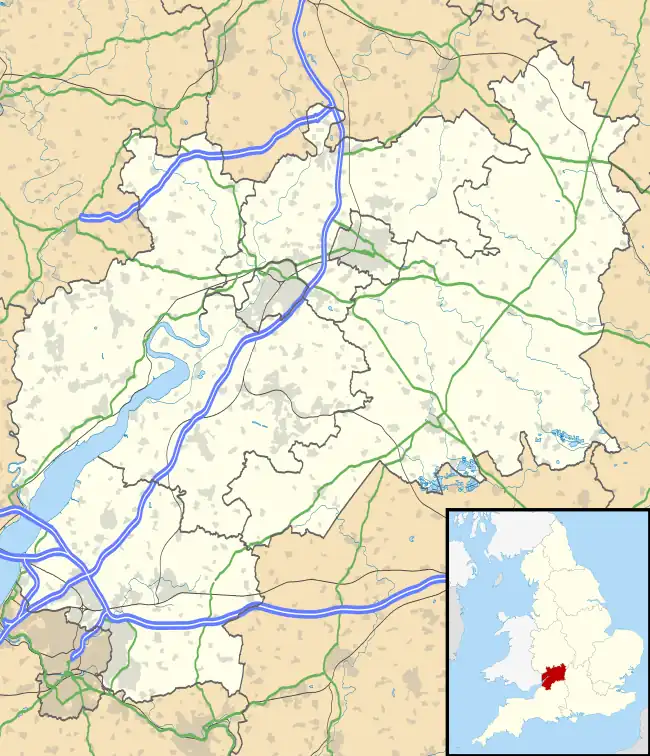Sherborne, Gloucestershire
Sherborne is a village and civil parish almost 3.5 miles (5.6 km) east of Northleach in Gloucestershire. Sherborne is a linear village, extending more than a mile along the valley of Sherborne Brook, a tributary of the River Windrush.
| Sherborne | |
|---|---|
 Sherborne Location within Gloucestershire | |
| Population | 309 (2011)[1] |
| OS grid reference | SP1614 |
| Civil parish |
|
| District | |
| Shire county | |
| Region | |
| Country | England |
| Sovereign state | United Kingdom |
| Post town | Cheltenham |
| Postcode district | GL54 |
| Dialling code | 01451 |
| Police | Gloucestershire |
| Fire | Gloucestershire |
| Ambulance | South Western |
The place-name 'Sherborne' is first attested in the Domesday Book of 1086, where it is spelt 'Scireburne', and means 'bright stream'.[2] This is a reference to Sherborne Brook.
Manor and church






Coenwulf of Mercia, who reigned from AD 796 to 821, is credited with giving the manor of Sherborne to Winchcombe Abbey.[3] The Domesday Book records that the abbey held Sherborne in 1086.[3] Edward I stayed in Sherborne in 1382.[3] In 1539 the abbey was suppressed in the Dissolution of the Monasteries and the Crown took its lands.
Sherborne had a parish church by 1175, when it was listed amongst the property of Winchcombe Abbey.[3] The original church building no longer exists, but a 19th-century cottage at the east end of the village incorporates two Norman doorways and other details[4] said to have been recovered from an orchard at the same end of the village.[3]
The present Church of England parish church of Saint Mary Magdalene is in the centre of the village. Its bell-tower and spire were built late in the 13th or early in the 14th century.[5] The church is next to Sherborne House, which was built for Thomas Dutton after he bought the manor of Sherborne in 1551.[6] Elizabeth I stayed at the house in 1592.[3] John Dutton had the house re-faced in 1651-53,[7] and James Dutton, 1st Baron Sherborne had alterations made to the church between 1743 and 1776, including the addition of a Doric portico.[3] In 1850-59 John Baron Dutton, 2nd Baron Sherborne had the medieval nave and aisle of the church demolished to allow more light into Sherborne House, and had a new nave and sanctuary built further north.[3][6] The church contains numerous ornate monuments to members of the Dutton family.[3][6] The tower has a ring of six bells.[8] The oldest is medieval; three more were cast in 1653 and the remaining two are 18th-century.[3]
In 1624-40 John Dutton acquired land 2 miles (3.2 km) southwest of the village to create a deer park.[3] He had The Lodge built as a viewing stand to watch deer being coursed by greyhounds.[7] In 1898 it was extended for Susan, Lady Sherborne and converted into a house.[9] The National Trust now owns the Lodge Park and Sherborne Estate.[10] Sherborne House is converted into privately owned apartments and is not open to the public.
Economic and social history
In 1086 the village had four watermills on Sherborne Brook.[3] By the end of the 19th century only Duckleston Mill, at the west end of the village, remained, and it was disused.[3] In 1961 it was still standing but had been converted into a farmhouse.[3]
The Astronomer Royal James Bradley was born in Sherborne[3] in 1693.
More than half of the parish was farmed under an open field system until 1777, when the common lands were enclosed.[3]
The farmhouse at Stones Farm at the east end of Sherborne village was designed by Richard Pace and built in 1818.[4]
The 2nd Baron Sherborne established two schools for boys in 1824. They were merged in 1862, and a schoolhouse was built for them in 1868.[3] By 1906 it had been enlarged to take 165 pupils, but by 1938 attendance had fallen to 80.[3] By 1961 it was a junior school.[3] It is now a Church of England primary school.[11]
Until the 1880s Sherborne was noted as a centre of Morris dancing.[3]
Sherborne still has a village shop and tea room[12] which incorporates an outreach Post Office.
Sources
- Elrington, C.R. (1964). Victoria County History: A History of the County of Gloucester, Volume 6. pp. 120–127.
- Verey, David (1970). The Buildings of England: Gloucestershire: The Cotswolds. Harmondsworth: Penguin Books. pp. 385–386. ISBN 0-14-071040-X.
References
- "Parish population 2011". Retrieved 25 March 2015.
- Eilert Ekwall, Concise Oxford Dictionary of English Place-names, p.416.
- Elrington, 1964, pages 120-127
- Verey, 1970, page 398
- Verey, 1970, page 394
- Verey, 1970, page 395
- Verey, 1970, page 396
- The Gloucester & Bristol Diocesan Association of Church Bell Ringers, Cirencester Branch
- Verey, 1970, page 397
- "Lodge Park and Sherborne Park Estate". www.nationaltrust.org.uk. Archived from the original on 2 November 2009.
- Sherborne Church of England Primary School
- "Home". sherbornevillageshop.com.